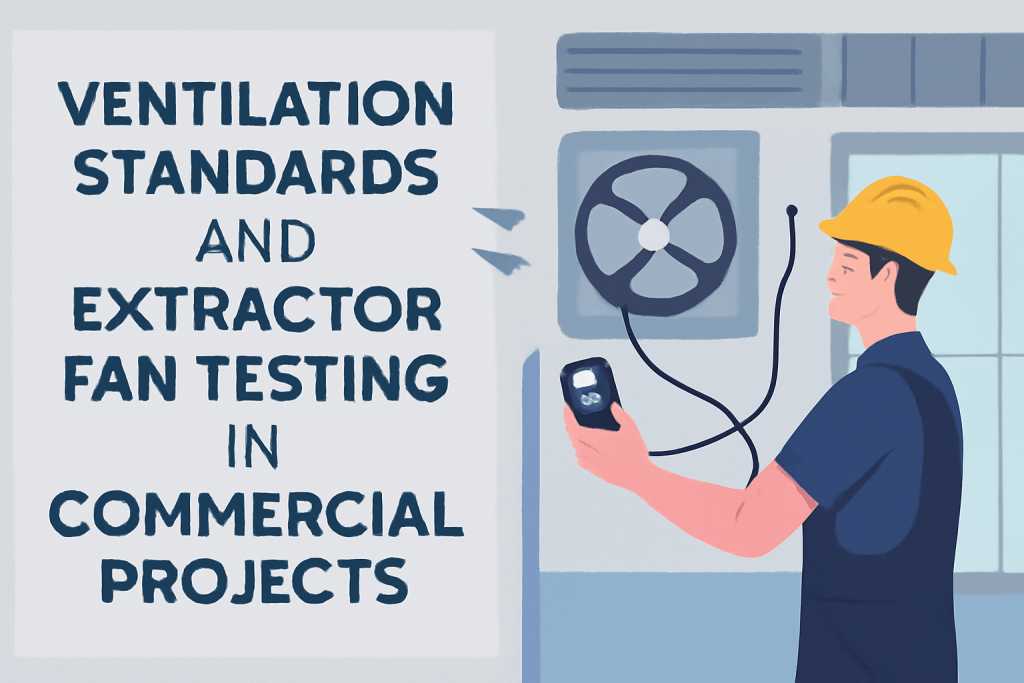Proper ventilation isn’t just a nice-to-have in commercial projects; it’s a must-have. Whether you’re managing a bustling restaurant kitchen, overseeing an office building, or running a retail space, ensuring clean, efficient airflow is critical for compliance, safety, and the overall well-being of occupants. Today, we’re going to tackle an often overlooked but essential part of ventilation systems in commercial buildings – ensuring they meet regulations with an extractor fan test certificate.
Wondering what on earth an extractor fan test certificate is or why it matters? Don’t worry—we’ll break it all down for you in the simplest terms, with a dash of humor and empathy to make an otherwise dry topic a bit more digestible.

Why Ventilation Matters in Commercial Spaces
Before we jump into standards and testing, let’s quickly cover why ventilation is such a key factor in commercial spaces. Poor ventilation is about more than just stuffy air. It can:
- Affect Health: Improper airflow means contaminants like dust, fumes, and allergens hang around. That’s bad news for anyone with respiratory issues or allergies.
- Lower Productivity: Ever notice how stuffy rooms can make employees sluggish? Quality ventilation improves air quality, which in turn can boost focus and energy.
- Violate Regulations: Commercial projects must comply with strict ventilation standards. Ignoring them can lead to fines or operational shutdowns.
- Present Fire and Safety Risks: Ventilation systems, particularly in kitchens or chemical-heavy industries, need regular checks to prevent fire hazards.
Understanding Ventilation Standards and Regulations
Commercial spaces aren’t all built the same, and neither are their ventilation systems. Think about it – a small café won’t need the same system as a manufacturing facility. However, some basic standards hold true across the board. Standards like ASHRAE in the U.S. or CIBSE in the U.K. serve as benchmarks for airflow rates, indoor air quality, and ventilation design.
Key Components of Ventilation Regulations
- Air Changes Per Hour (ACH): This measures how often the air in a particular space is replaced within an hour. For example, restaurants typically require more air changes than office spaces due to food preparation.
- Filtration Standards: Filters aren’t just for your Instagram photos. Regulations often outline the type and level of air purification systems needed to reduce contaminants.
- Noise Limits: Nobody wants to work or dine in a space that sounds like a small airplane hangar. The system’s sound level is another factor to keep in check.
- Maintenance and Testing: This is a biggie. Ventilation systems require ongoing inspections and tests to ensure they perform at an optimal level.
This is where testing and those all-important certificates come into play.
What Is an Extractor Fan Test Certificate?
Despite its intimidating name, an extractor fan test certificate does exactly what it sounds like. Think of it as a “report card” for your ventilation system, specifically for extractor fans. These certificates validate that your extractor fans are functioning correctly and efficiently meet relevant standards.
Extractor fans play a vital role in removing stale air, grease-laden vapors (in kitchens), or harmful substances (in industrial settings). Without regular testing, you could run into serious problems, including system failures, increased energy costs, potential legal fines, or worse, safety hazards.
What’s Checked During an Extractor Fan Test?
When your fans are inspected, a technician will typically look at:
- System Performance – Is the fan removing air efficiently?
- Contaminant Reduction – Are harmful particles being properly filtered and expelled?
- Energy Usage – Is the fan running efficiently without wasting energy?
- Noise Levels – Fans that sound like jet engines may not pass!
- Compliance – Does everything meet the necessary safety and building standards?
Once the test is completed and everything checks out, you’ll receive your extractor fan test certificate. This document proves you’re compliant and ready to breathe easy (pun intended).
Why Regular Testing is Essential for Commercial Projects
Neglecting regular extractor fan tests is like skipping oil changes for your car. Sure, you can get away with it for a while… until you can’t. Here’s why routine testing is non-negotiable:
- Compliance: Regulatory bodies can request proof of your certification during an inspection. No certificate = big problems.
- Cost Savings: Inefficient fans use more energy, translating to higher bills. Routine tests can catch these inefficiencies early.
- Safety: Extractor fans are crucial for reducing fire risks and maintaining safe air quality levels.
- Longevity: Regular testing helps detect wear and tear, extending the lifespan of your equipment.
Tips for Managing Ventilation in Commercial Spaces
Managing all aspects of a commercial ventilation system can feel overwhelming, but the right approach simplifies things. Here are some practical tips to stay on top of it all:
- Document Everything: Always keep a record of your extractor fan inspections, tests, and certifications.
- Schedule Maintenance Checks: Don’t wait until something breaks. Pencil in regular inspections with a qualified technician.
- Train Staff: If employees work closely with ventilation systems, ensure they understand the basics of operation and troubleshooting.
- Partner with Professionals: Choose reliable experts who’ll take the stress of compliance off your plate.
- Stay Updated on Regulations: Standards evolve, so make sure you’re aware of the latest requirements.
Breathe Better with Professional Support
At the core of any efficient, compliant ventilation system is regular testing and maintenance. An extractor fan test certificate isn’t just a piece of paper; it’s peace of mind for your business. Make sure you work with trusted professionals who prioritize quality and expertise.
If managing your ventilation feels daunting, take a breath (pun absolutely intended). Proper planning and regular testing can save time, money, and headaches, ensuring your commercial space is not only safe but also a pleasant environment for everyone who steps inside.
